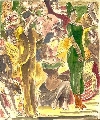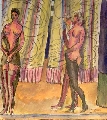Artwork
Zardinsh Adolfs
available 57 itemsAdolfs Zardins
(1890 08 II Riga, Latvia – 1967 07 II Jurmala, Latvia), painter.
Only in 1990 his relatives give his artistic heritage to publicity.
“I am 58, and in five Years my colors and lines will be genuinely perfect…”
“I don’t obey anything expert myself and my time…”
Indeed, he strictly followed this rule, set up by himself; he lived and created as an outsider, obeying only himself and his time, more accurately – his inner time. And he died without being known and acknowledged by his contemporaries. Adolfs Zardinsh – an artist whose creative work has no analogues in Latvian art history of the XX century. This may seem strange, but may seem strange, but maybe it is only natural that we have only fragmentary information about his life. The beginnings are to be sought during the WWI when the family of his father, Peteris Zardins, moved from Vecpiebalga (Latvia) to Vitebsk (Russia). There is a reason to assume that the development of the artistic personality of young Adolfs Zardinsh was influenced by the bustling art life in Vitebsk. As we know, after October 1917, there lived and worked such artists as Marc Chagall, Kazimir Malevich, Mstislav Dobuzhinski, Robert Falk, Janis Tillbergs, a. o. So, it might not be a coincidence that art critics have discovered the influence of M. Chagall in A. Zardinsh’ art works. About 1920, after his return from Vitebsk to Latvia, A. Zardinsh settles down at his sister’s place not far from Riga, at the Riga Bay, and stays there until the and of his days, leading a solitary life and creating frescoes, histrionic compositions, landscapes, portraits. Participation at there exhibitions of the Independent Artist’s union in Riga (1931, 1933, 1935) doesn’t make him famous or acknowledged. His friendship with the Lithuanian painter Vladas Eidukiavicius doesn’t help Adolf Zardinsh to enter the established artistic circle. He still stays the stubborn hermit whose authorities in art are Rembrandt and Velasquez. He takes over some stylistic elements from his favorite art styles French fauvists, German expressionists, Russian neo – primitivisms.
Nothing can divert him from his way - neither the fare with destroys many works, nor the deep poverty verging on hunger. If tacking money for good paints, the artist used the ones he has, if there is no paper or canvas, he paint on any background, frugally and carefully. If the composition does not satisfy him, he cuts the ready work in pieces and, using them, creates a new one.
His themes stay the years – high society, casino and theatre, genre scenes and erotica. Year by year the art works by A. Zardinsh turn move refined, his compositions – more harmonious, the choice of colors – more perfect. Many of his works can easily compete with masterpieces seen at famous museums.
He drew and painted since childhood, because he was born in a very intelligent family, where education was respected. His father dead at artist’s childhood and mother with 6 children moved to Vitebsk (1910 – 1917). In 1920, Zardins with his family returned to Riga.
He attended the Studio of Independent Artists and took part at all exhibitions, which were organised by this studio (1931, 1933, 1935). During these years, he painted a lot and draw with aquarelle and pastel small pictures and wrote idiomatic “diary”. After the 2nd World War he lived in cold and hunger, without decent materials for work. He is an individualist who lived in his own reality.
His works are full of classic themes (history, mythology, religion and erotics) but interpretation is paradoxical, associative, allegoric and also subjective. Zardins in his works created so-called “individual mythology”.
Exhibitions:
1931, 1933 and 1935 – group exhibitions of the Union of the Independent Artists;
Memorial exhibitions:
1998 – Riga;
1999 – Germany (Veclara)
1999 – Moscow, Pushkin State Museum of Fine Arts.
2006 – Italy
2019 - In Bucharest, at the main building of the Titulescu Foundation
„Adolfs Zardins” Catalogue. A.S. Pushkin of Fine art, Moscow, 1999, – Riga: R.: Neputns, 1999. ;
L. Pestova „Adolfs Zardins”, Riga.: Neputns, 2004.


























































